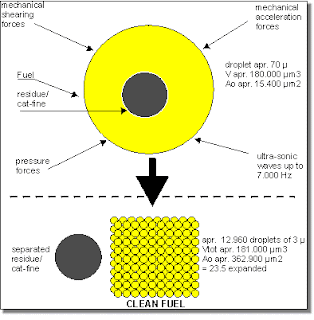What is Homogenisation?
Homogenise: a : to reduce to small particles of uniform size and distribute evenly usually in a liquid b : to reduce the particles of so that they are uniformly small and evenly distributed.
Residual fuel oil can be described as a combination of heavy asphaltene agglomerates and bituminous matter blended with lighter distillates. Sometimes the heavier constituents are not dispersed evenly in the fuel and stratification can occur. Sludge is produced by precipitation of suspended asphaltenes from the fuel – a common occurrence triggered by the high carbon content in heavy marine fuels.
When the fuel is injected into the engine the lighter factions burn first; the asphaltene agglomerates are very slow burning and sometimes do not burn completely, leading to deposits of heavy carbons and ash on pistons, exhaust valves and turbochargers.
If these heavy, relatively large particles of fuel can be broken down into smaller droplets, then the surface area is increased and the droplets will heat up more quickly and burn more efficiently with fewer harmful carbon deposits and lower equipment maintenance costs. With smaller particles passing through the purifier, sludge output is also greatly reduced
As far as we are concerned, a homogeniser is a piece if mechanical equipment which reduces the fuel oil particle size and evenly distributes them. If the fuel system is fitted with appropriate water dosing equipment it will also form a useable emulsion with water content up to 50%, leading to a 10%-NOx -reduction per 10% water. This system has been researched and developed by MAN B&W.
The advantages claimed for homogenisation are:
· improved operation efficiency.
· reduction of fuel stratification.
· reduced sludge build-up.
· prevention of sedimentation.
· improved power output.
· reduction of emissions.
How does it work?
there are different types of homogenisers, but basically the principle is to take a droplet of fuel and to chop it up using mechanical shearing and acceleration forces and ultrasonic waves to produce many thousands of much smaller droplets with a much greater surface area.
For example a droplet 100mm (microns) in diameter has a surface area of 31416mm2 If it is broken up into droplets of 5mm diameter, the total surface area increases by 20 fold; If broken up into droplets of 2mm diameter then the surface area increases 50 fold.
| Often the fuel droplet will contain unburnable residue, or a catalytic fine. Where this residue and fuel would have deposited as sludge, the unburnable residue is separated out and can be removed by the purifier. Likewise, the catalytic fine is now easier to remove by centrifuging |
.
| The homogenizer attacks sludge and combustion problems directly by mechanically reducing the size of asphaltene particles. Pumped through the machine’s concentric gears with cone-shaped grinding surfaces, heavy fuel oil is exposed to frictional forces that shear asphaltenes to well under the maximum size that manufacturers recommend for efficient operation. |
Positioning of Homogeniser.
This depends on the set up. Sometimes more than one homogeniser is employed. The fuel can be circulated through the homogeniser and back to the settling tank. To limit the amount of sludge loss through the purifier, the homogeniser can be placed in the system prior to the separator. For a system which is also going to introduce water into the fuel to reduce NOx emissions, The homogeniser is placed in the fuel pressure system before the engine fuel oil heaters.
Manufacturers:
SIT and Drew Marine manufacture homogenisers. The following web site and downloadable pdf file, from which information was taken for this page, may be of further interest:
Drew Marine http://162.128.70.45/DM/fuelmill.pdf
Not everyone is convinced that homogenisation is beneficial. The following report may be of interesting reading.
http://research.dnv.com/marmil/envact/Green%20efforts%20rapport_.pdf








Comments
Post a Comment